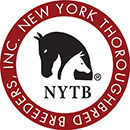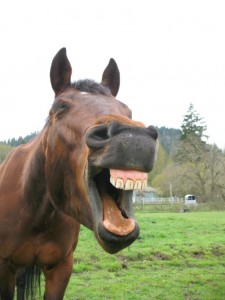This week in “Straight from the Horse’s Mouth,” we will be hearing from Mallory Mort, Farm Manager of Gallagher’s Stud in Ghent, NY. Mr. Mort came to Gallagher’s Stud in 1979, a year after graduating from Penn State with a BS in Animal Production. He is kind enough to give us his time and expertise regarding the best ways to keep your horses comfortable, happy and hydrated during the cold winter months.
“Mal as you know it’s been a bit of a wild winter, especially when you compare it to last year but we have had some pretty cold days and some frozen ground.”
Q. Impaction due to colic is always looming in the cold winter months and we know that colic is the number one non-infectious health risk in horses. What can we do to prevent colic in the winter?
A. Water and forage fiber (hay in the winter) are the two most important factors in equine digestive health. Most winter colics are caused by impaction (constipation) and the VAST majority of impaction colics in the winter are from dehydration – inadequate water intake. To highlight the importance of water intake, it is estimated that a horse could live for 20-25 days with adequate water and no feed but could only survive 3-6 days with no water and adequate feed. That is because of the high volume of water needed to keep feed (and later manure) moving through the horse’s nearly 100-foot long digestive tract. Even in winter, horses at rest need 7-12 gallons of water per day and, since they are naturally continuous grazers, they should have good quality hay available at all times. Alfalfa hay can act as a mild laxative and should be considered as part of a horse’s winter diet.
Q. Hydration for your horses is always tricky in the frigid temperatures. What are some tips to keeping our horses well hydrated in the winter?
A. It’s easy to say “make sure your horses have access to clean water at all times” but it can be more complicated than that with sub-freezing and even sub-zero temperatures in the winter. The most convenient way to assure continuous access to water is to install automatic waterers, but that is not always feasible. If you are watering with buckets or a stock tank, you should be using heated buckets or heaters designed for that use to ensure access to water at all times. As a safety note, be sure to shield all heaters and cords from your horses so as not to cause electrical shock or fire.
The Penn vet school did some studies in the mid-90’s that are still referenced by the AAEP and many publications. One of the findings was that horses whose water was heated to around 65 degrees drank 40% more water than horses given water at 32-38 degrees. That is a HUGE difference and more than enough reason to make sure your horses have heated water and don’t have to wait hours for someone to come break ice from their buckets.
Remember, ‘heated’ in this case does not mean ‘warm’. 65-degree water is not warm but it is considerably warmer than ice-water. Another interesting finding of their studies was that horses did most of their drinking within an hour of eating their grain or fresh hay and did 82% of their drinking within 3 hours of feeding. So if you are unable to assure full time access to water, you can maximize your horses’ intake by providing clean heated water shortly after feeding.
Horses should also have unlimited access to salt to help maximize their water intake. It is inexpensive and easily provided as a large or small block of plain salt (white) or trace mineralized salt (red).
Providing your horses with an unlimited supply of water (preferably heated), good quality hay (preferably with some alfalfa content), and salt should keep them hydrated and help avoid winter colic.
Q. What about mares’ water needs after foaling?
A. It is very important that postpartum mares drink some significant amount of water within an hour or so after foaling due to fluid loss from sweating, foaling, and probably not drinking for a period prior to foaling. Most mares, particularly older more experienced ones, after they’ve attended to their foal a bit will begin picking at some hay and have a drink of water. However, sometimes first-timers and mares who are completely consumed by caring for their foals, have no interest in drinking. You can try moving the foal near the mare’s water source to see if that might prompt her to drink. Otherwise you might consider giving your mare some electrolyte paste or some electrolyte powder mixed with feed. Observe your mare for urination as that could be an indication of her hydration level. Also observe her and her stall for the passing of manure. Most mares will pass a lot of manure prior to foaling so you may not see any for a while but you should see some by 8-12 hours post foaling and if not, you may want to consult your veterinarian.
It is debatable whether a hot bran mash is of any benefit as a laxative post foaling. Some research has shown it is not and in cases where wheat bran is not part of the horse’s normal diet it may cause a mild diarrhea by disrupting the microbial population of the gut. You may want to consult with your veterinarian about it.
Q. Should I add oil to my horses’ feed in the winter to keep things moving?
A. Vegetable oils are readily absorbed by horses and don’t pass far through the tract so they really don’t serve as a good digestive lubricant. Mineral oil is a good lubricant (which is why veterinarians use it to oil horses for transport, etc.) but most horses will not readily eat a significant amount in their feed. If you want to try feeding it, you should consult with your veterinarian about whether it is a viable or necessary option.
Q. Sometimes I see red or bright orange spots in the snow or shavings where my horse has urinated. Does this have anything to do with my horse being dehydrated or maybe another problem?
A. This is nothing to get alarmed about. Certain plant metabolites in a horse’s urine, after being exposed to the air for a while, mix with oxygen and turn a red, orange, or rust color. It is still a bit of a mystery why urine from some horses turns color and from others it does not. However, if you see red urine as it comes out of your horse, you should contact your veterinarian about it.
Thank you Mallory, Manager of one of the foremost thoroughbred operations in the country, Gallagher’s Stud. Watch for more helpful interviews and save the date for our next LIVE Educational Seminar on April 30 at the Fasig-Tipton pavilion! If you have any questions for Mr. Mort or comments, questions, feedback or suggestions for future dialogue, feel free to email them to: info@nytbreeders.org — TG










